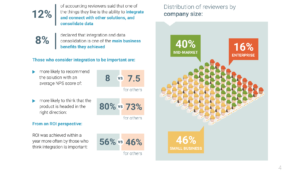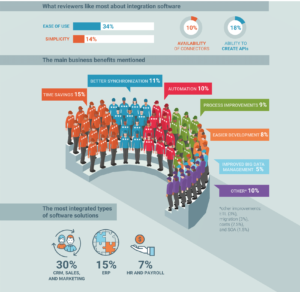Cloud Integration? G2 Crowd, empowering business buying decisions, weighs in!



Most companies use two or more software solutions to manage business operations. All these companies need to transfer data between solutions in order to ensure that they have a single source of truth. Companies that have invested in IT personnel and infrastructure tend to use FTP transfers, automated export/import, data warehouses, etc. All these options only provide partial integration between systems, leaving some business needs uncovered.
Data volumes would ultimately outpace manageability as your business grows. Pulling all your files from a secure server without the need of human manipulation significantly reduces the time required to process data and the data itself is inherently more secure.
Lack of integration causes processes to break down or take longer time. When companies can’t rely on integration, they tend to have two choices: either they enter data manually into multiple systems, or export data from one system and import it into others. Both options are error-prone and time-consuming, which impacts the integrity of data and the productivity of the users.
Finance
Lack of integration in Finance can have a negative impact on the efficiency of the accounting department and the profitability of the business. Accountants need a lot of time to pull data from separate systems, consolidate it, and import it into the accounting system. This usually leads to complicated processes every time a fiscal period needs to be closed, which can also impact other departments, as well as customers and suppliers.
 Customer Service
Customer Service
Customer satisfaction can also be impacted by a lack of integration between multiple systems such as CRM, field service management, call center software, knowledge management solutions, or online portals (including e-commerce).
 Sales & Marketing; Time Tracking
Sales & Marketing; Time Tracking
Marketing and sales professionals end up using multiple solutions because they either cannot afford a complete CRM solution or they have specific needs that aren’t covered by CRM, such as sales intelligence or marketing content management. The only way to address this issue is to use an integration framework that provides out-of-the-box connectors for dozens of software solutions, as well as the ability to easily create and modify new APIs.
Time tracking is an important challenge for both manufacturing and professional services companies. This information needs to be imported into an HR system to manage attendance and calculate payroll, then to an accounting system or ERP to process payments and calculate the cost of labor.
![]()
1. Everyone has the same information, including employees, customers, suppliers, contractors, etc. For eCommerce or online orders, everyone involved can see the information about the customer, including shipping and billing addresses, payment terms, and credit history.
2. There is no need for manual data entry, import and export of data, and the use of spreadsheets. A typical example of a double entry is when each department uses its own calendar for activities and there is no synchronization between them.
3. A change in one system can be reflected in all other systems – for instance, a product discontinued in ERP cannot be sold, bought, be available in inventory, or manufactured.
4. Ensures compliance in heavily regulated industries such as food manufacturing. Integration makes it easier for companies to find information for traceability purposes and quickly address issues like recalls of contaminated food.
5. Lowers IT costs by replacing costly data warehouses or in-house connectors that need to be updated for each new version of the solutions with which they are used.
6. Data consistency or standardization increases the accuracy of the information and simplifies data management.
7. Increased productivity for both IT personnel and all other employees. The time and effort needed to find information can be reduced, which allows employees to focus on what matters most.

Return on Investment
 Crowd data shows the ROI of software solutions for Integration can be as high as 20%. This is explained by a low implementation timeline (almost two months on average) and by the technical and business advantages.
Crowd data shows the ROI of software solutions for Integration can be as high as 20%. This is explained by a low implementation timeline (almost two months on average) and by the technical and business advantages.
SyncApps has proven that it’s a software worth investing in today for any organization needing integration between disparate data. SyncApps’ ROI can be seen in 7 months compared to the leading competitors. Good business people know that time is money so are choosing SyncApps makes great business sense.
Check out how SyncApps dominated against the leading cloud integration competitor Dell Boomi here!
Time Saving
 Another way to measure the success of an integration solution is to determine the time that IT teams saved by using it. Almost 16% of respondents indicated that they spend less time managing different systems after they implemented software for integration. Time savings can vary from days to “hundreds of hours of work each year”.
Another way to measure the success of an integration solution is to determine the time that IT teams saved by using it. Almost 16% of respondents indicated that they spend less time managing different systems after they implemented software for integration. Time savings can vary from days to “hundreds of hours of work each year”.
With SyncApps, going live takes less than a day. SyncApps users attest to the product’s easy-to-use, one-day setup process. SyncApps is an integration cloud that saves you tons of time by managing your business data. With SyncApps, you can synchronize your data from multiple applications in minutes not months.
Ease of Use
 Finally, in order to be efficient, a software solution has to be easy to use. 13% of reviewers mentioned simplicity and ease of use as being one of the most important advantages of an integration solution.
Finally, in order to be efficient, a software solution has to be easy to use. 13% of reviewers mentioned simplicity and ease of use as being one of the most important advantages of an integration solution.
SyncApps is an integration platform built with simplicity in mind. No advanced knowledge is required to use our integration platform. It has a simple point and press interface to manage all your mission-critical operations. Whether you are integrating with an Email Marketing System, eCommerce, Financial Applications, Time Tracking, or Support.
SyncApps is the #1 cloud integration software. With its powerful features, syncing data is now easier than ever.
Get Started with your cloud integration project today! Try SyncApps today!